The subject of today’s review is the TX-L37V20B, a slim-line edge LED LCD offering from Panasonic. The Panasonic TXL37V20B is a feature-rich flagship model catered for the rich to be used as a secondary display. So without further ado, let’s move on to our Panasonic TX-L37V20B review.
Note: The specific model we tested was the Panasonic TX-L37V20B which is the 3-pin-plug British version, although retailers may advertise the LED TV as Panasonic TX-L37V20, Panasonic TXL37V20B or Panasonic TXL37V20. These terms are used interchangeably throughout this review article to refer to the same HDTV.
Design
In recent years, Panasonic adopted a rather interesting choice of designs that received mixed views from the masses. Thankfully, the chosen design of Panasonic TXL37V20B is outstanding, and will no doubt complement most interiors. However, the overall presentation is slightly tarnished by use of plastic finish – it would have been better to offer full metallic casing given its cost, status and target audience. Hopefully Panasonic will return the days of old and adopt designs that were iconic and instantly recognisable.
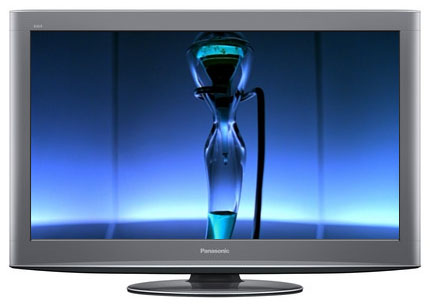
Assembling the Panasonic TX-L37V20 panel to its pedestal stand is quite easy and straight forward. It is ideal to have a partner to help, but it can be assembled alone provided the person possesses both strength and balance.
For the green-minded, the Panasonic TXL37V20B features a hard power switch on the right, which can be used to fully shut down the display.
Connections
The location of the AV ports and the build quality are in keeping with Panasonic’s standards. The PSU is located on the right and the main board (which contains the processing elements) is located on the left.
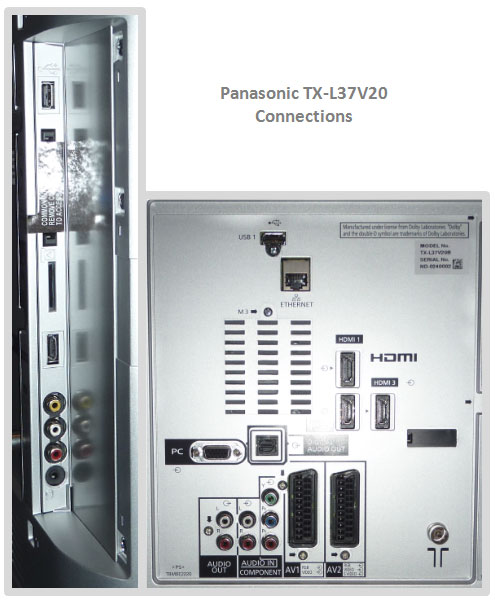
Operation
The Panasonic TXL37V20B features the classic Panasonic GUI with one exception, [isfccc], which allows users to configure greyscale and colour via 2D RGB-CMS. The ability to finetune gamma is still absent, making it difficult to obtain flat 2.2. Navigating through various layers of the menu is effortless thanks to the clean layout and rapid responsiveness. However, Panasonic still hasn’t added numerical values, which can prove frustrating during calibration. It is also worth noting that the image reset option doesn’t provide confirmation warning, so settings can be lost quite easily.
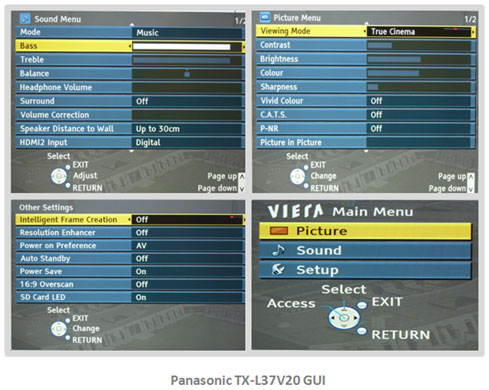
Like competing models, the Panasonic TX-L37V20B also features independent source customisation, but only in the Professional Modes.
Remote
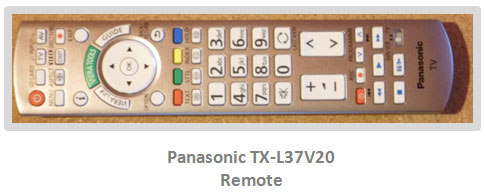
I’ve always been a fan of Panasonic’s remote controls due their excellent ergonomics, responsiveness, button layout and design. The supplied remote was in keeping with that design philosophy with minor modifications to accommodate the new features.
Calibration (Greyscale, Gamma & Colour)
Greyscale and Gamma accuracy are vital for portraying a given image correctly. Therefore, the display must be calibrated to a set of standards used by the industry. In the case of HDTV, the set standard for colour space is Rec. 709 (which is similar to sRGB, sharing an identical white point of D65), and we chose the gamma value of 2.2.
Greyscale calibration ensures all greys between black and white are free from colour dominance, which is achieved by assigning the RGB values to 6500K Correlated Colour Temperature (CCT). Regrettably, it’s not possible for any HDTV display to yield 100% accuracy. So the goal is to maintain errors within acceptable levels, which are indicated by Delta E (dE) values.
After some basic calibration, our Panasonic TXL37V20B review sample yielded excellent RGB Levels in both Professional [1] and True Cinema modes. Sadly the CMS (which is active only in Professional Mode) implemented on the Panasonic TX-L37V20B is flawed. Prior to calibration, I normally evaluate the HDTV’s processing of YCbCr and RGB by using a test pattern designed to highlight visible banding/ posterization, which helps me ascertain the appropriate format to use for a particular TV as some process RGB better than others, and vice versa. Upon testing I discovered that in Professional Mode [1] and [2], the Panasonic TX-L37V20 failed to display the colour transitions correctly. The same artefact occurred when Vivid Colour is enabled in non-professional modes. Therefore, the following assessment is based on the True Cinema Mode as there’s no other solution to amend the issue at present.
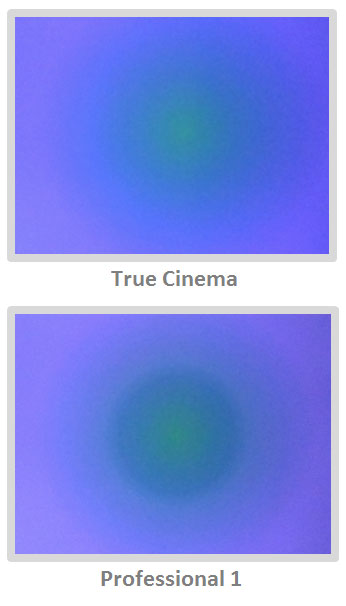
Note: The results below were obtained by placing the colorimeter at the centre of the screen to minimise measuring errors.
Greyscale
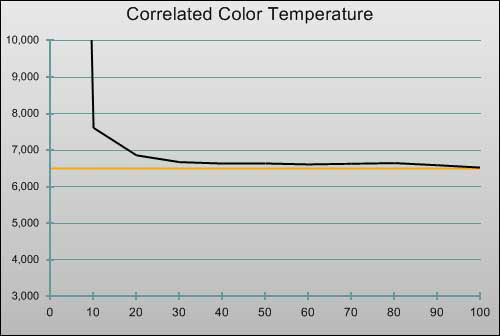 |
| Pre-calibration CCT in [True Cinema] mode |
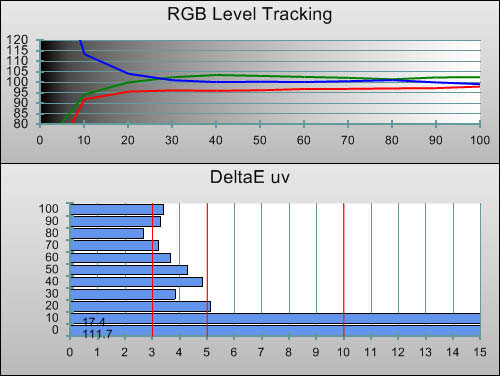 |
| Pre-calibration RGB tracking and delta errors (dEs) |
![Post-calibration CCT in [True Cinema] mode](/news/wp-content/uploads/2018/04/hdtv_Panasonic-TXL37V20B_post-cct.jpg) |
| Post-calibration CCT in [True Cinema] mode |
![Post-calibration RGB Tracking in [True Cinema] mode](/news/wp-content/uploads/2018/04/hdtv_Panasonic-TXL37V20B_post-rgb.jpg) |
| Post-calibration RGB tracking and dEs in [True Cinema] mode |
Gamma
![Gamma curve in [True Cinema] mode](/news/wp-content/uploads/2018/04/hdtv_Panasonic-TXL37V20B_post-gamma.jpg) |
|
| Gamma curve in [True Cinema] mode | Corresponding gamma tracking |
Colour
![Post-calibration CIE chart in [True Cinema] mode](/news/wp-content/uploads/2018/04/hdtv_Panasonic-TXL37V20B_post-cie.jpg) |
| Post-calibration CIE chart with reference to HD Rec.709 |
![Post-calibration Luminance levels in [True Cinema] mode](/news/wp-content/uploads/2018/04/hdtv_Panasonic-TXL37V20B_colour-luminance.png) |
| Post-calibration colour luminance (coloured bars = targets; black bars = measured values) |
Benchmark Test Results
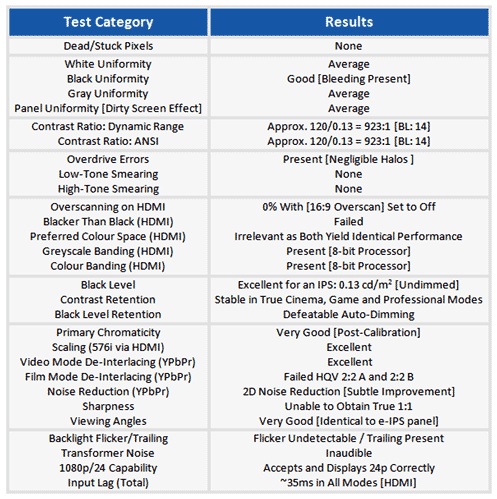
Power Consumption

Uniformity
Our Panasonic TX-L37V20B test unit produced average overall screen uniformity, which is rather bizarre for an IPS-based LCD panel. During the pure white test (100IRE), the classic red and green tinting was visible (but acceptable), and the same applies to backlight bleeding. Thankfully, bleeding was only visible when the screen is virtually devoid of content. Normally IPS-based LCD panels have good to excellent panel uniformity but our Panasonic TXL37V20B review sample had odd smudges that were visible during panning (commonly referred to as dirty screen effect). Such imperfections are nothing drastic or new, but can annoy some users. Considering the price tag of the TX-L37V20, Panasonic should have demanded better quality panel from LG Displays.
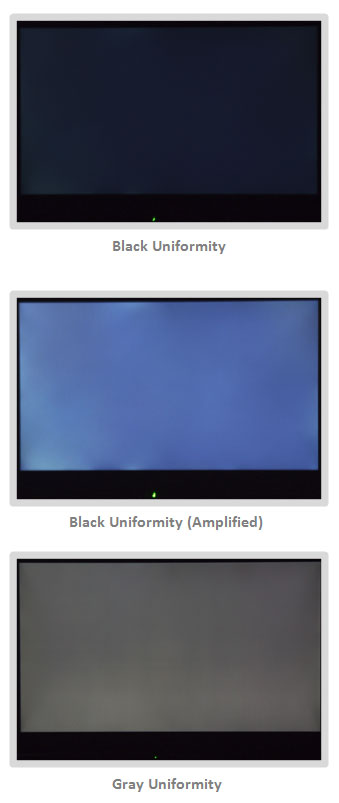
Contrast Ratio
The Panasonic TX-L37V20B in [True Cinema] mode with white level (contrast) set to 14 yielded dynamic range and ANSI contrast ratio of 923:1, which is rather excellent for an IPS-based LCD, but significantly inferior to Vertical Alignment [VA] based LCDs and Plasma Display Panels. For the same price, the plasma version (the Panasonic TX-P42V20) offers black level that is quite a bit darker. Alternatively, the Samsung LE40C650 LCD fitted with SPVA panel is not only vastly cheaper, but also capable of delivering deeper blacks.
![]()
Motion Performance
PixPerAn is an excellent tool designed to evaluate motion artefacts and as expected, the motion rendered by the Panasonic TX-L37V20B was free from artefacts caused by pixel lag. However, like the Samsung UE32C6000 I’ve reviewed earlier, the Panasonic TX-L37V20 suffers from doubling effect (original image accompanied by two or more distinctive ghost images) during fast motion. To amend the issue, the contrast must be set to maximum and power saving should be disabled, which are of course not recommended. Alternatively, setting Intelligent Frame Creation [IFC] to Mid does significantly improve motion performance.
In addition, just like the Samsung UE32C6000, the effect of doubling on the Panasonic TXL37V20B can only be observed with content that are free from blur or with negligible blur. So it only affects a minority of contents (mainly games and sports). We believe the prime suspect is the pulsing backlight; more accurately, as the power to the LEDs decrease, the latency between each pulse increase, which seems to be out of sync with the LED LCD display. We have no proof of this, just theories.
Panasonic is one of three manufacturers with effective MCFI algorithms at their disposal so it’s not surprising to find IFC reducing blur effectively without adding highly visible artefacts to the image. However, there is no option to control the level of frame interpolation as the user is only presented with three simple options of [Off], [Mid] and [Max], which not only applies to high-motion but also to low-motion content. So the user would have to periodically access the set-up menu to manually enable and disable IFC according to the content as it is not possible to customise such option for each input. It is also worth noting that low-motion to high-motion conversion was poor in comparison to Splash Pro and TX-37G20 as the algorithm failed to maintain a stable lock, and artefacts populated certain scenes even when set to Mid. With that in mind, I would advise using IFC only on high-motion content.
Overscanning: It can be disabled via the Setup menu, but is applied to all external inputs by default. So users would have to enter the Setup menu periodically to adjust the option depending on the content.
Blacker than Black (HDMI): The Panasonic TX-L37V20B failed to display 0-255 correctly via HDMI (RGB).
Viewing Angle: Panasonic LCD TVs are known for their excellent viewing angles thanks to the IPS-based panels. However, the viewing angles of Panasonic TXL37V20B were identical to my Dell 2209WA, which initially led me to question the panel type. The LG’s AS-IPS panel embedded within the Panasonic TX-L37V20 has excellent horizontal viewing angles, but the black does glow when viewed from above or below the panel. So it’s best to position the Panasonic TX-L37V20B to eye level.
Sharpness: The Panasonic TX-L37V20 has an odd bug that somehow links both brightness and sharpness. Setting sharpness to -5 (0 being its default value) softened the image and caused visible moire in the [Eizo Moire Test Pattern 1], and its intensity varied according to the brightness setting. It is something I’ve never encountered before, and I was forced to compensate by adjusting sharpness to -4, which did add a small degree of visible edge enhancement. So in that sense, I wasn’t unable to obtain true error-free 1:1 mapping. Increasing the sharpness value did not completely eliminate moire but it did reduce it to negligible level. It is worth nothing that the effect of moire does not affect daily viewing – it’s only a problem when the Panasonic TXL37V20B is used as a monitor.
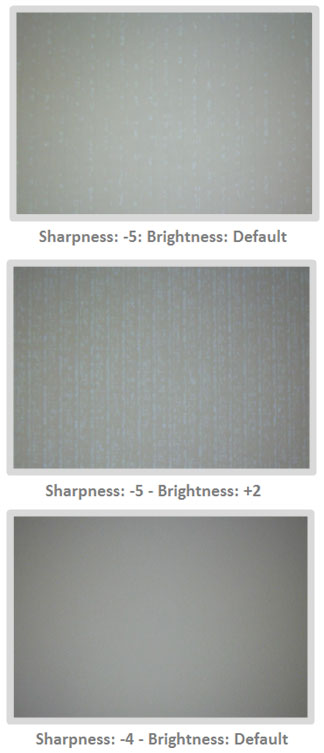
Picture Quality
To evaluate the picture quality rendered by the Panasonic TX-L37V20B, a small number of carefully chosen images are used to detect visible artefacts and errors. The first image Aeon is used to detect errors in skin-tone, luminance and depth, while the second image Acela Express is used to detect greyscale and gamma errors in addition to black crush.
Note: The following tests were conducted under the [True Cinema] mode.

The Panasonic TXL37V20B yielded excellent results following basic calibration in True Cinema mode. The mass shades of warm colours that envelop Charlize Theron’s face, neck and chest were clearly visible – very close to a calibrated display. A sense of depth was also present.

As predicted, the performance of the Panasonic TX-L37V20B was excellent and comparable to the calibrated Dell 2209WA. There was no visible evidence of any serious black crush nor any form of gamma error.
High Definition
The majority of high-definition content on the Panasonic TXL37V20B were beautifully rendered despite the issues mentioned above. Colours, depth and noise were all kept to the standard expected from Panasonic. However, content that rely on deep blacks to convey an immersive and thrilling experience left a lot to be desired. Decreasing the contrast value to minimum did drop the black levels to respectable 0.08 cd/m2 with whites peaking at 80 cd/m2, which is borderline tolerable for certain material such as the Alien Quadrilogy. But, it’s not possible to fully defeat the dreaded bluish blacks.
Although the Panasonic TX-L37V20B utilises 8-bit processing, banding was kept to an absolute minimum provided the source is clean. However, considering its price, the Panasonic TX-L37V20 should have the ability to reduce or eliminate banding native to low-bandwidth content. Thankfully, playback of 24p material is faithful to its source as expected from Panasonic. In fact, the motion is comparable to digital cinemas.
In terms of artefacts, it would seem MCFI (motion-compensated frame interpolation) cannot be fully disabled on the Panasonic TXL37V20B except in Game Mode. When I viewed content with short burst of intense whites (e.g. music videos), I started noticing artefacts that often occur when MCFI is enabled. Oddly, the motion didn’t appear to be interpolated. On a positive note, Game Mode did eradicate the issue, but it doesn’t allow users to select various aspect ratios, and cannot be enabled when using the TV’s internal tuner or built-in features.
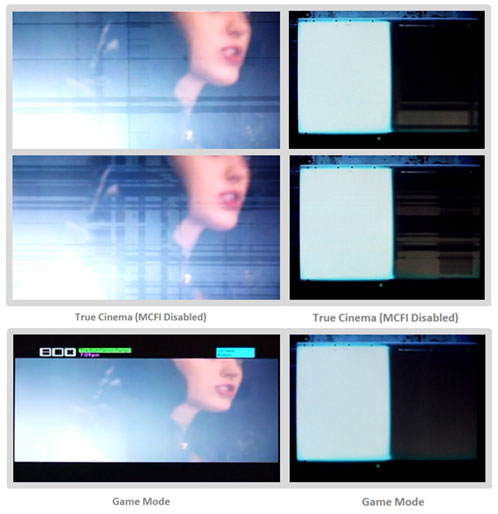

Standard Definition
The Panasonic TX-L37V20B produced excellent results with negligible noise via RGB SCART. Those with standard Sky or retro gaming console will appreciate the quality of colour and detail.
- Scaling: Upscaling 576i via HDMI and RGB SCART produced excellent results comparable to ATI’s UVD 2.2.
- Film and Video Mode Deinterlacing: The Panasonic TX-L37V20 did an excellent job of reducing aliasing to negligible levels during deinterlacing of high-motion content. However, the Panasonic TXL37V20B failed the PAL 2:2 pulldown test.
- Digital Noise Reduction: Panasonic’s implementation of 2D noise reduction system does reduce noise, but it’s not very effective.
Gaming
Panasonic HDTV displays have always been excellent for gaming, so it comes as no surprise when I say the Panasonic TX-L37V20B is an excellent casual gaming display. Oddly enough, the input lag remains at a tolerable level even with MCFI enabled. On the negative side, users may notice ghost images due to the pulsing backlight. Gamers who often play 60p games may want to invest in a Panasonic NeoPDP plasma for smear-free/blur-free motion with ultra-low input lag, but be sure to factor in phosphor trailing as it may exasperate users who are sensitive to uneven phosphor decay.
Audio Performance
The audio performance of the Panasonic TXL37V20B is quite impressive for an LED LCD TV, but this is hardly surprising since the TV has larger speakers. Although the sound is detailed and pleasing in Music Mode, I did detect a gap between low-end and lower mid-range, which could have been improved via the on-screen audio equaliser that is unfortunately inaccessible in Music Mode. Switching to User Mode did allow me configure various frequencies but the audio sounded dull and lifeless. Put simply, Panasonic has embedded quality speakers with average audio signal processing. Hopefully this can be addressed via a firmware update so users can fully utilise the speakers.
Alternatively, it may be better to invest in the Creative GigaWorks T20 Series II, which can be connected to the Panasonic TX-L37V20B’s 3.5mm headphone jack. Not only does this pair of external speakers provide detailed highs and mids, it also delivers deep bass equivalent to a 2.1 set-up.
Conclusion
Pros
- Excellent HD Performance
- Excellent Design and Build Quality
- Excellent Performance After Basic Calibration
- Very Good Primary Chromaticity and Excellent Greyscale
- Inaudible Transformer Noise
- Responsive Remote
- Good Sound Quality
- Superb SD Performance via SCART
- Relatively Low Input Lag
- Effective Deinterlacing
- Effective MCFI (High-Motion to 100/120p Conversion)
Cons
- Doesn’t Accept Blacker than Black (HDMI-RGB)
- Average Overall Uniformity
- Average Dynamic Range and ANSI contrast Ratio
- Visible Artifacts in all Modes Except Game
- Sharpness issue and Moire
- Faulty CMS
- Visible Ghost Images due to Off-Sync Backlight
- Ineffective MCFI (Low-Motion to High-Motion Conversion)
- Unified MCFI, Resolution Enhancer and 16:9 Overscan Cannot be Customised Per Input
- No Headphone Volume Control on the Remote
- Picture Settings Cannot Customize Per Input (Accept in Professional Mode)
- Inferior Viewing Angles Compared to IPS Alpha (IPS Provectus)
- Failed to Detect Film Cadences
- 2D Noise Reduction
Summary
Panasonic LCD TVs have always remained in the shadows of their plasma cousins purely due to the lower price-performance ratio, which has yet to change for the better. For £1000 (the current retail value of the Panasonic TX-L37V20B), one can easily opt for the TX-P42V20 plasma (or the upcoming GT series with 3D capability). If plasma is not an option, there are still plenty of LCDs that offer better value for money, which is why I have some reservations in recommending the Panasonic TXL37V20B.



Thanks for the review.
I thinking to buy a LED panasonic for the low input lag rate. I see that the lag rate is the same as the D25 model.
Is the same panel? What do you recommend me?
Plasma is not a choice…
Thanks a lot
Nice review, Nielo!
I see “…Banding (HDMI): Present (8-bit processor)” in (post-calibrated?) Benchmark Test Results for all your reviews.
Any comments? And what 2010 TV have less noticeable banding?
Thanks!
A little bit input lag…
Only one question: “Qualified recommendation” is worst than “Highly recommended/recommended”?
Yes. From worst to best:
Below Average
Average
Qualified Recommendation
Recommended
Highly Recommended
Reference Level
@NIELO: yet another AMZAING piece of work from you! how do you put so much love into this job? forumers love you, and other LCD sites wish they could do the stuff you do!
like SERG & Kanbei i wish to be clarified on the following:
this is a 8 bit panel; the D25 is avvertised as a 10 bit, it it true?
the V20 panel is from LG (even in 37″?) and the 42D25 is from panasonic ? (i thought thet only produced small ips….)
“Doesn’t Accept Blacker than Black (HDMI-RGB),Visible Artifacts, Sharpness issue and Moire, Faulty CMS, Visible Ghost Images” etc….correct me but, the D25 Does not suffer from any of these issues….
All in All is the D25 better than this V20? how is that possible this is the high end model?
thanx again for all the effort
@ Franky: For gaming [TV], IPS panel is the best closely followed by MVA. So either opt for the low-end Panasoic or LG model.
@ Serg: Thanks. I have yet to review any 2010 model that doesn’t have banding. However, the 46B750 I’ve reviewed last year did feature 10-bit processing and the Sharp LE700 has the ability to switch between 8-bit and 10-bit.
@ nenito2k: Thanks for the complements ^_^. We are just a team of volunteers as the profit is used to maintain the site, so it’s not exactly a job ;).
The V20 is indeed advertised to have 10-bit panel, but it’s not a native 10-bit panel as all consumer panels are 8-bit (simulated to 10-bit either via dithering or FRC or combination of both). In the case of V20, it seems 8-bit source is not processed in 10-bit domain. So I believe in order to take advantage of 10-bit color, you’ll need to input 10-bit source. TBH, this is very typical of Panasonic. Their processing needs to improve to complement the quality of the panel.
As for the panel, it seems Panasonic is contracting LCD from LGD, which is nothing new of cause. But I don’t know if they are contracting all LED-LCD from LGD or just a few.
The D25 may have have similar issues or the V20 I received from Panasonic is completely different or faulty. Since I didn’t review the D25, I can’t comment on its performance. But if Panasonic ask me to review another V20, I’d be happy to do so and update the review accordingly.
Thanks a lot Nielo, but there is something that I dont undestand..
In avforum they analize the same model and the input lag rate is only 10ms?
How ever, in the same web, the D25 model says 35 ms of lag…
In Hdtvtest you analize both and say that have the same inpunt lag rate…
How is mistaken?
Im confused!!!,
thanks a lot and sorry for my poor english…
It definitely didn’t have 10ms lag. Not only I was able to detect lag but it was also confirmed by the lag test.
The Panasonic LCDs I’ve reviewed have also matched up with ~35ms – 10ms would be exceptional and easy to detect with nearly any console FPS game.
Thanks a lot Nielo and David.
I know that plasma are the best Tv to play consoles but I had a G20 and I was able to see phosphor trails so I think the best option, in my opinion, in lcd, is panasonic…
If Plasma isn’t an option, I would advise the Samsung C530s. We didn’t have a chance to check the 40″ model yet, but the 32″ has almost no input lag, surprisingly…
Another excellent review Nielo. Keep raising the bar, and maybe other reviewers will follow.
Just don’t get it. How come the SL90 has a contrast ratio 800 and something and is not good. Then this is just a bit higher and it is considered excelent for IPS panel?
@ Andre: I’ve stated it’s excellent for an IPS as the improvement is higher than previous panel and it’s close to the 1000:1 barrier. However, I did state that the black level is quite average in comparison to VA and PDP.
First of all, thanks for the great review!
But I´m still confused about the input lag. As Franky stated a few posts before, AVF measured different levels on the same model. Without game mode, they measured about 40ms, which would be roughly the same like your 35ms (considering the inevitable measurement tolerances), but with game mode activated the lag should drop to about 10ms accordingly.
But you stated that there is no difference in lag wether game mode is activated or not. Wouldn´t that be strange, as game mode completely tweaks MCFI, which is known as a source of input lag? I mean, including a game mode would be rather pointless if it just disables MCFI (and thus drops motion resolution) without any benefits in terms of lag.
But if there is reallly no difference, do you know any possible explanation for AVF´s results?
There are multiple factors that can contribute to input lag (e.g. overdrive, panel processing, image processing etc.). Game Mode does fully disables MCFI, but the lag remains somewhat unaffected.
Maybe I received a faulty model, but if you’re after a gaming panel, there are plenty of alternatives for fraction of the price.
@Invader Zim: (thanks for the reminder BTW, I should dig out my DVD box set sometime):
I’ve tried out a V20 LCD with Game mode on and I can assure you the lag is not 10ms in Game mode. It feels much slower than TVs with measure at around 20ms. You would have to ask AVForums how they measured that – it’s perhaps the lowest figure rather than an average.
Thanks for the info Nielo and David..
Sure they measured the lowest figure….
Im sure that the V20 panel is the same as the D25
Thank you, Nielo and David, for your answers. I´m still a bit wondering why there´s apparently no difference wether game mode is on or off… this is quite unusual for a LCD equipped with MCFI. But if you were playing on two different sets, then I don´t think Nielo tested a faulty one. Seems like Panasonic created a completely disfunctional game mode.
Maybe it´s a recommendation for gamers looking for a LCD with relatively low lag while using MCFI, but if you want a set with as little lag as possible, there are far better alternatives, as Nielo said.
Sonys EX402 should be a good one – I don´t have any numbers, but as it features the same good old Bravia Engine 2 which made Sonys V/W/Z4*00 almost free of lag, it´s hard to imagine it differs in this respect. But this model is not to be confused with EX403 which has quite more lag due to BE3.
PS: Nice to see another IZ-fan, David… most people I know haven´t even heard about the irkens. ;)
As it turns out, Sony BRAVIA Engine is just marketing term (akin to Samsung’s Hyper Real Engine) and the actual processor varies according to model. So some contains NEC’s LSI while others contain Trent Micro LSI and NXP LSI. So 403 doesn’t contain the same processor found in earlier Sony models.
http://www.avforums.com/forums/12774364-post49.html
Upon testing, the KDL-32EX403 produce lag of 40ms in all modes. so it’s better opt for the Samsung models, which feature Trident LSI and panels from Samsung SDI and AUO.
Even if there are different processors working in the respective models, in all reviews of Sony LCDs on HDTVtest there are certain similarities between all models with the same BE:
BE2: low lag (0-10ms in game mode), average scaling, rather poor deinterlacing (esp. no film cadence detection)
BE3: high lag (varies at around 40-60ms in game mode, rarely 30-40ms), better scaling compared to BE2, good deinterlacing (very good cadence detection)
Therefore I think there must be distinctive spec, which each chipset has to match if it´s used in a certain version of BE. But the different chipsets (together with measurement tolerances) could explain the differences in lag between models featuring BE3.
The big question is, wether the EX402 (labeled BE2, sold only in continental Europe) has different spec as the EX403 (labeled BE3, sold only in UK), or not. It would be a gross disinformation of customers, if Sony puts different labels on exactly the same entry-class LCD, just regarding to the location it´s sold… :(
Here´s a link to the EX402 on the German Sony HP, information on BE is found under “Bild”:
http://www.sony.de/product/t32-ex-series/kdl-40ex402#pageType=TechnicalSpecs
Sorry for getting OT in the comments!
@Invader Zim: I think, that EX402 and EX403 have different specs. In Europe, there is another TV from EX400 line – EX40B: http://www.sony.de/product/t32-ex-series/kdl-40ex40b#pageType=TechnicalSpecs
I think, that it should be EX403 without Freeview HD (DVB-T2) tuner.
EX40B is a bit out of the normal range of models, as it features a built-in BD-Player (funny idea, btw). But you´re right, this one is labeled as BE3 just like the EX403.
I just don´t understand why the Panasonic TXL37V20B has got so different reviews – a mixed bag here and on on AvForums this tv is praised to be the best LED seen on the Market at the moment.. Strange? Who´s review is the most correct? Confusing for potential buyers.
It is certainly not the best LED-LCD and even Panasonic would agree as they’ll be releasing the NeoLCD with local-dimming very soon. LG also has excellent LED line-up along with Sony and Philips.
Also, there’s always the P42V20 (2DTV) and P42GT20 (3DTV)
If you going for a 37″ Panasonic LCD would you recommend this TV or the S20 or G20 which have the Panasonic’s IPS-Alpha panel rather than one by LG?
“AvForums this tv is praised to be the best LED seen on the Market at the moment..”
Bit of a misquote there JSV, they don’t say anything of the kind, just that the reviewer thinks its one of the better LED edge lit sets he has seen.
Correct quote from AVForums:
“The Panasonic TX-L37V20B represents the very best of current LCD display technology and incorporates many performance enhancing features”
…. …
“Ultimately though the TX-L37V20B provides some of the best out of the box images I have seen to date from an LCD TV and this coupled with the excellent features and very reasonable price means that I have no hesitation in giving this display a Best Buy award.”
Interesting conclusion – I like the current Panasonic LCDs, but I would never say they were the best in class because of IPS’ inherent black level limitations, personally.
With that said, the reviewer was possibly comparing them to the Samsung LED-lit screens, which have some irritating issues (poorer viewing angle, auto-dimming, screen uniformity) which Panasonic’s are largely of, from my experience.
“It is certainly not the best LED-LCD and even Panasonic would agree as they’ll be releasing the NeoLCD with local-dimming very soon. LG also has excellent LED line-up”
When can we expect to see these new tv’s from Panasonic and will there be 37 inch? Are any of the 37 inch LGs any good? I’m after a 37″ LED-LCD tv and have been considering either the panasonic 37V20 or the 37D25 model, but after this review and other reviews regarding edge lit LEDs I’m seriously thinking about the samsung 37C605 instead.
Hi, I read both the 37S20 and 37V20 reviews. According to the review 37V20 has visible artefacting when the 100Hz interpolation is activated.However no such thing is mentioned in the 37S20 review. Is this because the two models have very different interpolation engines or simply because of the different reviewers?
I would also like two ask for advice. I currently own Panasonic 23LX70. I would be completely content with it if it were not for the annoying stutter/judder it exibits when feeded with 24p signal. From what I’ve read the TV just doesn’t support 24p and is converting the signal to 50Hz or 60 Hz producing the annoying effect. I’m looking for a set that does properly show 24p, has produces no judder appart from what is inherent to 24p films and has a frame interpolation which can be switched of. I’ve narrowed my choice to Sony 40EX500, Toshiba 46XV733 and Panasonic L42S20. Which of the three will best suite my needs :)? Or do you have any other suggestions?
Sorry, I’ve got Pana 32LX70 :)
@Hristo: it is likely the 37S20 features the same artefacting. Although I didn’t see anything blatant during the review, I would expect these systems to produce errors by their very nature.
Out of those three, I would personally lean towards the Sony for its better contrast level.
@ David Mckenzie:Thank you for answering that quickly. Does any of the three sets have any problems withmotion, especially 24p motion? And by problems I mean any judder/stutter not present in the original signal. You have reviewed Toshiba SL753 and I guess the signal processing in XV is the same.
can you please give me the calibrated settings for this tv, pretty please.
I have just purchased the TXL37V20B and must say that I am very disappointed
with the overall performance
HD viewing is watchable but I have seen far better quality on less expensive sets.
SD quality is abysmal although switching to scart does improve it a little.
I watch Freesat via the foxsat HDR and on my previous set had a far better PQ
without the inconvenience of switching modes I am very close to returning the TV unless someone has any help to offer.
Thank you for the excellent review, especially for showing the artifacts during content with short burst of intensive whites. These artifacts are visible for me in SD and HD, mostly in scenes with very fast movements (e.g. explosions, flurry of camera flashes, people quickly moving by). That’s pretty annoying! By turning IFC on I can avoid these artifacts, but IFC makes the picture jerky from time to time. Like mentioned in your review the only way to get a perfect picture while watching DVDs and Blu-rays is to turn on the Game mode.
Do you think Panasonic could fix that problem with a software update? How would you name these artifacts? I’m thinking about writing a complaint to Panasonic so it would be good to know.
And are there any settings that I could choose to avoid these artifacts while watching TV programmes?
I would appreciate your help very much. Thanks in advance!
I have just come across this site whilst looking for a TV to replace a faulty Panasonic TX-L37S20B. I am interested to see that you had an issue with visible black banding with True Cinema enabled on the music video and that it disappeared with Game Mode switched on. I had exactly the same black banding on my S20 and assumed it was a fault with the TV, as it did it on all sources and Panasonic were unable to produce the same fault on a TV they had in their lab. I am starting to think it is a faulty batch of panels that got out? Given that I bought my TV at the end of July and this was reviewed at the beginning of September it’s possible.
In case anyone is interested I have a film of the problem on youtube and I have included a link to it.
I would be interested to hear any comments on the video.
Thanks,
A
Sorry, link is: http://www.youtube.com/watch?v=NmKGQAkaomw
hi
I gonna through the TX-L37S20B led tv but i found picture blurring problem and picture quality was so dull against to LG. if you want to play game with excellent results so why don`t go with LG 42SL9000 LED base LCD could have best gaming aspect. it provides us unbelievable fun while playing game on it.
could you make review of Panasonic TXL32E30, i hope is good for gaming
@elvinas: We will lodge a request with Panasonic.
Warmest regards
Vincent
thanks for reply Vincent